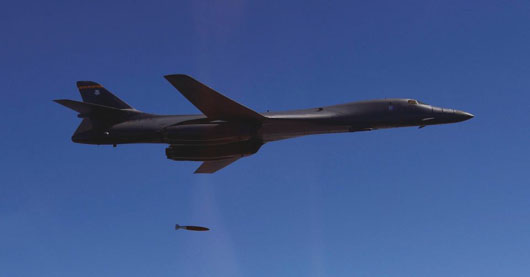by WorldTribune Staff, August 31, 2017
The United States and South Korea carried out a major show of force on Aug. 31, staging air-to-ground precision-strike drills near North Korea’s border in response to Pyongyang’s continued missile launches.
Two U.S. B-1B supersonic bombers and four F-35B stealth jets trained with South Korea’s F-15K fighter jets over the Korean peninsula, the Seoul’s air force announced.

An official from Seoul’s Defense Ministry said the B-1Bs were flown in from Andersen Air Force Base in Guam while the F-35s came from a U.S. base in Iwakuni, Japan.
The unprecedented combined maneuver included MK-84, MK-82 and GBU-32 bombs that were dropped in the precision-strike drills that were held over the Pilseung Range in the eastern mountainous province of Gangwon, Yonhap reported.
Also mobilized was a KC-135 Stratotanker aerial refueling plane, a South Korean defense source said.
“Our Air Force has the capability of conducting perfect combined operations,” said Lt. Gen. Won In-Chul, commander of the South Korean Air Force Operations Command. “No matter when, how and where the enemy provokes, we will perfectly retaliate to make it feel an insurmountable sense of fear and deep regret.”
U.S. President Donald Trump tweeted on Aug. 30: “The U.S. has been talking to North Korea, and paying them extortion money, for 25 years. Talking is not the answer!”
The war games were held two days after North Korea fired an intermediate-range ballistic missile (IRBM) over the northern territory of Japan.
“North Korea’s actions are a threat to our allies, partners and homeland, and their destabilizing actions will be met accordingly,” said Gen. Terrence J. O’Shaughnessy, Commander, U.S. Pacific Air Forces.
“This complex mission clearly demonstrates our solidarity with our allies and underscores the broadening cooperation to defend against this common regional threat. Our forward-deployed force will be the first to the fight, ready to deliver a lethal response at a moment’s notice if our nation calls,” O’Shaughnessy added.
Gen. Vincent K. Brooks, commander of U.S. Forces Korea (USFK), noted that the U.S. military opted for the show of force due to the North’s disregard for Washington’s conciliatory gesture.
“The U.S. did not dispatch bombers during the recently concluded exercise in hopes that the reduced scale would send a positive signal to North Korea and the region,” Brooks said. “Instead, North Korea responded to the gesture.”
Brooks cited the North’s recent rehearsal of special operations raids against South Korea’s border islands, three short-range ballistic missile firings and the IRBM launch.
Lt. Gen. David H. Berger, commander, U.S. Marine Corps Forces Pacific, underlined the combat readiness of his troops armed with the fifth-generation F-35 fighter jets.
“By forward-basing the F-35, the most advanced aircraft in the world, here in the Pacific, we are enabling the Marine Corps to respond quickly during a crisis in support of Japan, the Republic of Korea, and all our regional partners,” Berger said.
North Korea’s state-run media mouthpiece, KCNA, said in a statement that Pyongyang “can never stop bolstering up the nuclear deterrent,” and added that “no one can guess when a nuclear war may break out.”
The KCNA statement added: “The USA’s more persistent moves to launch a nuclear war on the Korean peninsula would precipitate its final doom.”
Subscribe to Geostrategy-Direct __________ Support Free Press Foundation
